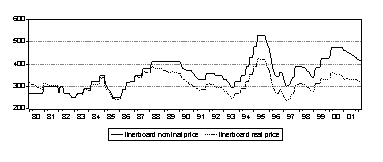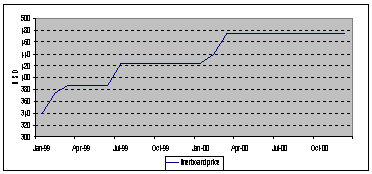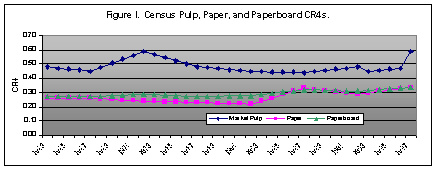
|

|
Projects Price Volatility
Price Volatility, Inventory and Industry Consolidation Learn More: Background | Full
description
Background
Purpose, Goals and Literature Review The purpose of this proposed project is to extend t he ongoing project, “Price Behavior (and Forecasting and Elasticities) in Pulp and Paper Industry.” This price behavior project was awarded in August 2001. We expected to complete the project by August 2004. As can be seen from our annual reports, we have been making significant progress in the existing price behavior project. In particular, we have constructed a sophisticated project web site. On this web site, we regularly update price charts for containerboard and pulp, including price charts for recent years as well as historical price movement for twenty years. More importantly, we have built real-time forecasting tools on the web site for the industry. These forecasting tools can be used for short-term forecasting on sales, inventory and even prices. They can generate online forecasts with graphs based on a user’s specifications and can update the forecasts as frequently as the user likes when new data become available. In addition, we have constructed a large data base with hundreds of variables that are useful in studying the pulp and paper industry. On the research front, we have completed a report on the industry review and a report on price forecasting, and have submitted a research paper on demand estimation to the Journal of Forest Economics. Currently, we are in the process of estimating demand and price elasticities of containerboard using simulation equation system model; and applying the recent advance in demand study, the random coefficient discrete choice model, to study the substitution pattern between different paper/board grades; and employing non-linear forecasting methods, neural network models, to improve price forecasting. During the two-year period of this project, we have received numerous requests from industry analysts, managers, and researchers in the related fields for our reports/papers, data, and advices. We have also been invited by the International Union of Forest Research Organization to join their project. As we enter the final year of this project, it becomes clear to us that, first, after spending enormous amount of time in learning to understand the industry and in collecting industry related data, we are prepared to do more in-depth researches for this industry. And second, based on our work in the existing price project, with some additional time, we can substantially expand our project to further investigate some issues that are very important for this industry, and get a much better understanding of price behavior. Therefore, we propose to expand the current research on price behavior. Our research in the existing project has touched many important aspects of price behavior; and yet these aspects are not covered in the scope of the current price project. They include price volatility, the structural impact of inventory on price changes, the effect of industry consolidation on price volatility and profit margin, and the cost effect of price volatility and its impact on vertical integration. We believe that these questions are very important both for the industry and for academic research, and they are well worth a thorough investigation. In addition, since the existing project focuses explicitly on the containerboard sector, studying these new issues will also move our research into pulp and paper sectors. We propose to complete the extended research on price behavior in less than two years. The proposed research will be conducted by a smaller team that mostly consists of members in the existing price project. With only a portion of the time and the cost of the existing price project, we expect to produce the same amount of outputs (reports and papers). The proposed project will proceed in four dimensions in order to deepen and widen the scope of the existing price behavior project. Dimension I: Price Volatility – The first dimension is to study the dynamics of price volatility in order to understand the underlying processes that drive such volatilities. As can be seen in the following graph, in the long term, the price movement of linerboard displays substantial fluctuations (and the volatility of pulp price is even larger). This property of volatility is known as time-varying volatility, which has crucial implications for risk management and pricing in any market. It also has direct implications for forecasting of future prices. The forecasting models utilized in the existing price project do not allow for the possibility of incorporating time-varying volatility dynamics into the forecasting functions. Our objective is to study volatility and risk in the pulp and paper industry by utilizing recent econometric methods that allow one to model directly the time-varying volatility and subsequently utilize these models in forecasting both the price dynamics and future volatility in the market. To our best knowledge, there is one study, Fromson (1997), on price volatility in pulp and paper industry. Fromson studies the volatility in pulp prices, but does not model volatility directly.
In the existing project, we have focused on the price level and price responses to other economic factors, not the price volatility per se. However, the dynamics of price volatility reveal additional information on price movement, and thus have important values both to academics and to the industry. Moreover, the volatility dynamics in prices can be used to generate advanced models to improve the forecasting of long-term price movement. In addition, the dynamics of price volatility can provide some basic information on the need for the pulp and paper industry to hedge risks such as developing or expanding futures markets. Dimension II: Inventory and Short-term Price Changes – The second dimension of the proposed project is to build structural models to predict short-term price changes. Price changes directly cause price volatility, and long term price fluctuation is a result of short-term price changes. Obviously, price volatility is affect by a large array of variables from demand side and supply side. We have been studying these effects using complicated structural econometric models in the existing price project. However, as can be seen in the following graph, short term price changes can have a very different pattern. For example, in a two-year period from 1998 to 2000, prices only changed 3-4 times.
It is generally difficult to use other economic factors to predict price change in a short term such as next month because of the timing of the data availability. Also, usual forecasting methods generally cannot estimate the probability of price change. Therefore, it is desirable to have a structural model to predict price change based on some leading indicators. Such a model can provide very useful information for the industry in production planning (for example, in planning downtime). Based on our findings in the current project, an inventory change generally occurs ahead of a price change. Thus inventory changes cause price changes in some causality sense. Since no study exists about the short-term effect of inventory on price in the pulp and paper industry, we will model the probability of price decrease or increase based on inventory. This is also a natural extension of our existing work on price forecasting, i.e., from forecast price to forecast the probability of price change. Dimension III: Price Effects of Industry Consolidation – The third dimension of this proposed project is to examine the effect of industry consolidation on price. We will specifically investigate whether the consolidation has any effect on price level, price volatility, and profit margin. There is a vast literature about the effect of market concentration on the price and price-cost margin. However, the existing studies mostly cover airline, banking, advertising, gasoline and grocery retailing industries; or they are based on cross industry data. There is no major study on these issues for the pulp and paper industry. It is known that industry consolidation has two potential effects: a higher price and/or a lower cost (higher production efficiency). Clearly, the latter effect is desirable from any prospect. Although consolidation becomes a hot topic in recent years in the paper industry, its effect on price, cost, profit margin, and price volatility is still largely unknown. In the existing project on price behavior, we have touched these issues indirectly. Based on our preliminary results from the structural demand/supply model, consolidation in the containerboard industry does not show any effect on price level. This finding is not surprising given the relatively low concentration in the paperboard industry. As shown in the following graph, based on the concentration measured by the percentage of capacity of the top four producers in the total industry capacity, the paper and paperboard industry is still not highly concentrated.
If consolidation has not increased the price, then it is natural to ask whether it has resulted in lower costs and/or lower price volatility. If this is the case, the consolidation has positive effects in improving production efficiency. Therefore, this study has important implications for the industry as well as for the government regulatory agency. Dimension IV: Price Volatility and Vertical Integration – The final dimension of this proposed project is to study the strategic decision of vertical integration (e.g., a paper/paperboard company takes over a pulp company), specifically the impact of price volatility. It is known that transaction cost is a main reason for vertical integration. Price volatility represents a large portion of transaction costs for downstream producers. For example, excessive volatility of pulp price will create a large degree of uncertainties for paper and paperboard producers and thus result in a large transaction cost. If this is the case, it is desirable for paper and paperboard producers to vertically integrate with pulp mills. There have been a number of papers that examine vertical integration in the pulp and paper industry. Ohanian (1994) studied historical pattern of vertical integration from 1900 to 1940. The most recent study is done by Melendez (2002) in her Ph. D. dissertation. Although these studies examine the effect of transaction cost on vertical integration, the effect of price volatility is not explicitly investigated. Our study of the effect of price volatility as a transaction cost on the decision of vertical integration will provide insight on whether a vertical merger would be more cost effective and logistically efficient. In summary, these research dimensions proposed are natural extensions to the existing price behavior project. Moreover, each dimension is also internally connected with each other centered at price. Building on these two projects, we will get a fairly detailed picture of price behavior, from its movement and its volatility (as well as the causes) to how we can predict them and how the industry can do about it (consolidation, vertical integration, or other such as inventory and downtime management).
Bollerslev, T. (1986), Generalized autoregressive conditional heteroskedasticity, Journal of Econometrics 31, 307-327. Bollerslev, T., Chou, R.Y., and Kroner, K.F. (1992), “ARCH modeling in finance: A selective review of the theory and empirical evidence”, Journal of Econometrics, 52, 5-59. Bradburd, Ralph M.; Caves, Richard E., “ Transaction-Cost Influences on the Adjustment of Industries' Prices and Outputs,” The Review of Economics and Statistics, (Nov. 1987). Carlson J. and W. Dunkelberg (1989). “Market Perceptions and Inventory-Price-Employment Plans”, The Review of Economic and Statistics, 71(2), pp. 318-324. Diebold, F. X. (2004), Measuring and Forecasting Financial Market Volatilities and Correlations. New York : Norton. Diebold, F. X. and Lopez, J. (1995), Modeling Volatility Dynamics, in K. Hoover (ed.), Macroeconmetrics: Developments, Tensions, and Prospects. Boston : Kluwer Academic Press, 427-472. Engle, R. F. (1982), Autoregressive conditionally heteroscedasticity with estimates of the variance of United Kingdom inflation, Econmetrica 50, 987-1007. Fan, Joseph P. H., “ Price Uncertainty and Vertical Integration: An Examination of Petrochemical Firms,” The Journal of Corporate Finance: Contracting, Governance and Organization (Dec. 2000). Fromson, D. A. (1997), Market pulp volatility still likely despite efforts to stabilize market, Pulp and Paer, 71, 104-104. Hay, G. (1970), “Production, Price, and Inventory Theory, “American Economic Review, 60, pp. 531-545. Koller, R. H. II , Weiss, L. W. (1989), “Price Levels and Seller Concentration: The Case of Portland Cement,” in Weiss, L. W. ed., Concentration and Price, M.I.T. Press, Cambridge , Mass. McIntosh J., Schiantarelli F., Breslaw J., and W. Low (1993). “Price and Output Adjustment in a Model with Inventories: Econometric Evidence from Categorical Survey Data”, The Review of Economic and Statistics, 75(4), pp. 657-663. Melendez, Marcela (2002), “ A Dynamic Model of Vertical Integration for the American Pulp and Paper Industry,” Yale University Ph.D. Dissertation. Newbery, David M. (1998), “ Competition, contracts, and entry in the electricity spot market,” RAND Journal of Economics; Winter98, Vol. 29 Issue 4, p726-760. Ohanian, Nancy Kane (1994), “Vertical Integration in the U.S. Pulp and Paper Industry, 1900-1940 ,” The Review of Economics and Statistics, Volume 76, Issue 1 (Feb., 1994). Pesendorfer, Martin (1998), “ Horizontal Mergers in the Paper Industry ,” NBER working paper 6751 (Oct. 1998). Robinson, Terry and Baniak, Andrzej (2002), “ The Volatility of Prices in the English and Welsh Electricity Pool,” Applied Economics v34, n12 (August 2002): 1487-95. Schmalensee, R. (1989), “Inter-Industry Studies of Structure and Performance,” Handbook of Industrial Organization, eds. R. Schmalensee and R. Willig, North Holland : Amsterdam . Weiss, L. W. (1989), “Concentration and Price,” ed., M.I.T. Press, Cambridge , Mass. Werden, Gregory, J. (1991), “A Review of Empirical and Experimental Evidence on the Relationship between Market Structure and Performance,” Economic Analysis Group Discussion Paper 91-3, Antitrust Division, Department of Justice. |
|
© 2003 - 2007 Center for Paper
Business and Industry Studies. |


